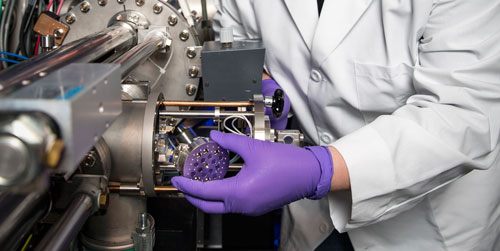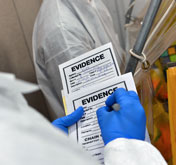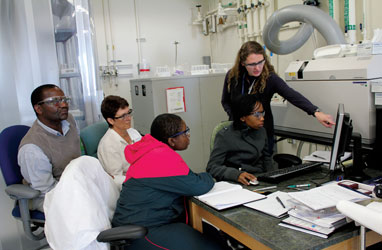Livermore’s Predetonation Nuclear Forensics Program Combines Operations, Research, and Outreach to Enhance Nuclear Security
As a leader in operations, research and development, international outreach, and education for predetonation nuclear forensics, LLNL advances U.S. capabilities and the underlying science.
Addressing a National Security Need
Nuclear forensics science—or nuclear forensics—seeks to deliver technical conclusions to law enforcement and nuclear security experts regarding nuclear materials found outside regulatory control. Predetonation nuclear forensics focuses on interdicted nuclear or other radioactive materials, aiming to answer fundamental questions regarding the nature of the material and the threat it poses, its intended purpose, and its origin. In addition to providing information used in legal proceedings to prosecute the smugglers, nuclear forensics provides information necessary to identify nuclear security vulnerabilities and prevent additional material from falling outside regulatory control. Lawrence Livermore has been a leader in nuclear forensics since the early 1990s, and over the last few decades, the tools used for nuclear forensics have become increasingly important in the fight against illegal trafficking of nuclear and radiological materials.
Lawrence Livermore is one of two laboratories designated by the U.S. government to perform operational analysis of bulk special nuclear material (SNM) for nuclear forensics. Our expertise in, and historical knowledge of, nuclear materials has enabled Livermore to become the premier laboratory for nuclear forensics analysis of bulk SNM. Our scientists continually generate reliable, high-quality analytical results that are legally defensible in a court of law, while, at the same time, we continue to advance the state of the art. Through these efforts, the Laboratory provides the technical information and data needed by decision makers for law enforcement and nuclear security purposes.
At the Forefront of Progress
The Laboratory is home to an exquisite combination of nuclear forensics facilities, instruments, and personnel. Our analysis tools include a variety of spectrometry, chromatography, and microscopy techniques for determining the isotopic, elemental, molecular, and physical characteristics of a sample. Lawrence Livermore scientists have access to approximately 20 state-of-the-art scientific instruments across the Laboratory for conducting nuclear forensics analyses. One of the most important analytical tools for nuclear forensics is the multicollector inductively coupled plasma mass spectrometer (MC-ICP-MS), which provides high-accuracy measurements of the isotopic composition of a sample. Using MC-ICP-MS, a sample is aspirated as a solution into an inductively coupled plasma. The high temperature of the plasma breaks the sample down into its constituent atoms and ionizes them. The instrument can analyze a broad range of elements, including those that are difficult to analyze by other methods.
The Laboratory’s high-resolution secondary ion mass spectrometer (NanoSIMS), one of only several such instruments in the United States and the only one focused on nuclear forensics, also offers exceptional characterization capabilities (see front image). The instrument uses a finely focused primary ion beam to erode ions from a sample’s surface. These secondary ions are then analyzed to reveal the elemental and isotopic composition of a sample’s uppermost atomic layers. The Laboratory has a number of research and development efforts under way to further improve all of its analysis techniques and increase the fidelity and precision of results.
Promoting International Engagement
Livermore scientists are at the forefront of international collaboration in nuclear forensics and efforts to advance technical capabilities in the field. From building nuclear forensics tools “at home” to teaching good laboratory practices abroad, Livermore is engaged in a global undertaking to keep nuclear materials under regulatory control.
Our international efforts fall into three broad categories. First, Livermore experts work with international organizations, such as the International Atomic Energy Agency (IAEA), to provide familiarization training in nuclear forensics for countries across the globe. Second, staff work collaboratively with countries who seek to improve their nuclear forensics capabilities, by identifying and providing specialized training, both at the Laboratory and in their home countries, and by helping them improve their infrastructure for nuclear forensics analysis. Third, Livermore personnel work with advanced countries on a peer-to-peer basis to further the state-of-the-art in nuclear forensics and build mutual confidence in each other’s nuclear forensics capabilities. These collaborations are critical to building an international network of nuclear forensics investigators who can identify material outside of regulatory control and compare results to identify linked seizures and to disrupt trafficking attempts. Lawrence Livermore also engages in multilateral meetings that bring the larger international community together to share information and continue training in stateof- the-art nuclear forensics, including IAEA nuclear security conferences, meetings of the Nuclear Forensics International Technical Working Group, and supporting U.S. government sponsors at the Nuclear Forensics Working Group of the Global Initiative to Combat Nuclear Terrorism.
Training the Next Generation of Forensics Scientists
The Nuclear Forensics and Attribution Act specifically tasks the Department of Homeland Security’s (DHS’s) Domestic Nuclear Detection Office with creating a development program for fostering and maintaining the nuclear forensics workforce into the future. Efforts include establishing a clear pathway from undergraduate studies to postdoctorate study in disciplines relevant to technical nuclear forensics and providing necessary scholarships, awards, and funding opportunities for such education. LLNL supports all of these efforts—from undergraduate familiarization and training to postdoctoral research opportunities. For example, LLNL’s Glenn T. Seaborg Institute runs an eight-week summer internship for students interested in nuclear forensics and related disciplines. LLNL routinely hosts multiple DHS graduate and postdoctoral fellowship winners. Students can interact with premier researchers and access equipment and facilities not available anywhere else. These efforts serve to build interest and longevity into the workforce pipeline for nuclear forensics and foster prospective LLNL employment opportunities.







